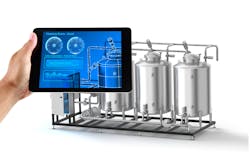Clean-in-Place Utilities and Automated Reporting Analytics Replace Manual Recording Tasks
Suboptimal systems drive up costs. Even a few minutes of downtime aggregated over the course of a year can add up to major costs.
But digitally transformed and optimized processes can help offset those losses and, according to folks at Emerson, it is why the development of energy and water consumption forecasting tools have never been more relevant.
Better yet is the development of a single tool to monitor energy and utilities parameters, and to improve efficiency and productivity, particularly for the food and beverage industries and environments where clean- and steam-in-place operations are required.
A Clean in Place (CIP) Utilities and Automated Reporting Analytics package, developed by Emerson, can optimize utilities consumption and generate automated reports as part of an energy reduction and productivity improvement plan. The software can serve either a single system or be applied throughout a plant or facility.
Read More: Optimizing Linear Motion Solutions Using Hybrid Automation Systems
The Clean In Place (CIP) Utilities and Automated Reporting Analytics package is delivered via PACEdge and Movicon platforms on an industrial edge control device. The software converts manual and semi-automated systems into digital systems. It is used to optimize utilities consumption, benchmark cycles and generate automated reports. The analytics point the way to reducing energy consumption and improving productivity.
According to Emerson, the CIP not only replaces manual checking of tasks and data entry but also reduces the time and resource-intensive cleaning processes. The tool can help companies reduce changeover times, increase uptime and productivity in either a single system or throughout the facility.
“Food and beverage manufacturers typically spend about 30% of utility costs on clean-in-place operations," said Amit Patel, digital transformation marketing manager at Emerson. "They also lose time between changeovers and spend between 20 to 40 thousand dollars in labor costs for manual reporting.”
How Digitalization Features Improve Throughput:
- Equipment Agnostic. The software is compatible with any CIP equipment and can be layered into an existing system, or Emerson can provide a turnkey solution of hardware, instrumentation, valves and analytics.
- Real-time Monitoring. The comprehensive package consists of software, controllers and sensors that track energy and utilities consumption and provide intelligence on each cycle. Depending on the facility’s automation needs, an edge-computing device may be installed to enhance data collection and to generate real-time monitoring and automated reporting.
- Benchmarking & Actionable Insights. The CIP Utilities & Automated Reporting Analytics software package assists operators in forecasting energy use, water consumption and resource needs. Generated reports can be used to meet regulation compliance, plan system maintenance, schedule downtime and order media supplies. In addition, Emerson noted that deeper analytics can be used to identify insights and trends that support predictive maintenance schedules and facilitate standardization of CIP processes across production facilities.
Read More: Barely There: Replacing Manual Operations with Lights-out Processes
About the Author

Rehana Begg
Editor-in-Chief, Machine Design
As Machine Design’s content lead, Rehana Begg is tasked with elevating the voice of the design and multi-disciplinary engineer in the face of digital transformation and engineering innovation. Begg has more than 24 years of editorial experience and has spent the past decade in the trenches of industrial manufacturing, focusing on new technologies, manufacturing innovation and business. Her B2B career has taken her from corporate boardrooms to plant floors and underground mining stopes, covering everything from automation & IIoT, robotics, mechanical design and additive manufacturing to plant operations, maintenance, reliability and continuous improvement. Begg holds an MBA, a Master of Journalism degree, and a BA (Hons.) in Political Science. She is committed to lifelong learning and feeds her passion for innovation in publishing, transparent science and clear communication by attending relevant conferences and seminars/workshops.
Follow Rehana Begg via the following social media handles:
X: @rehanabegg
LinkedIn: @rehanabegg and @MachineDesign
